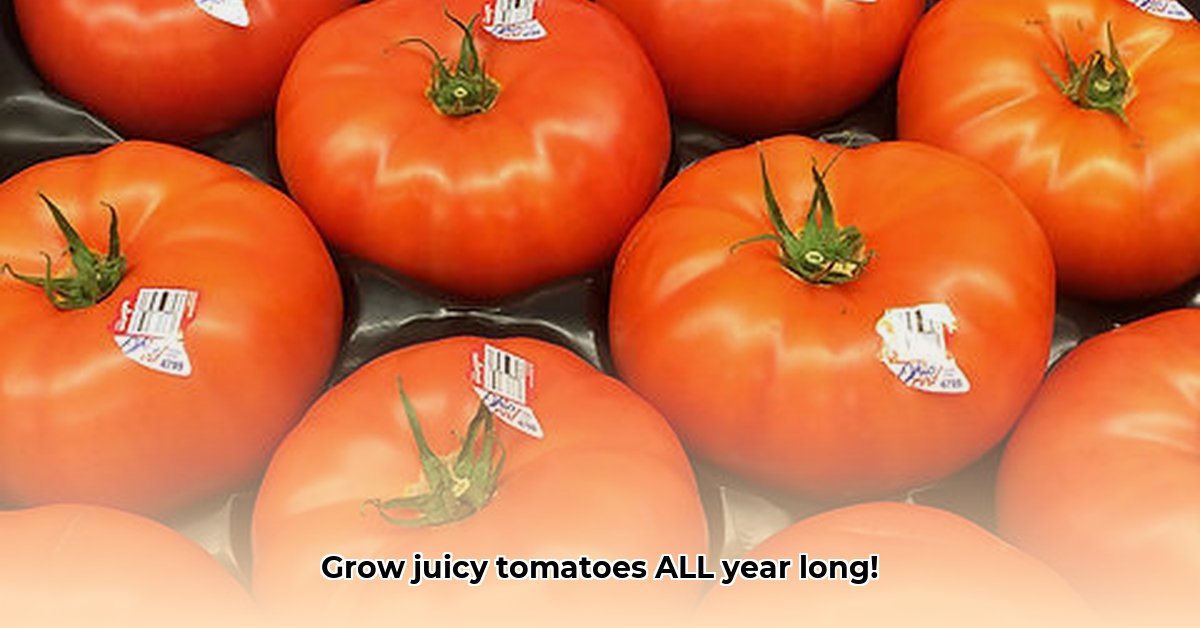Want juicy, delicious tomatoes all year round? Growing them in a hothouse can be the answer, but it’s more complex than simply moving plants inside a greenhouse. This article explores the world of hothouse tomatoes, comparing them to their field-grown counterparts, examining what makes them unique (both the good and the bad!), and sharing the secrets to a successful harvest.
The Controlled World of Greenhouse Tomato Cultivation
Hothouse tomatoes – those consistently red temptations available year-round – offer undeniable convenience. But do they truly rival the flavor of sun-drenched, outdoor-grown tomatoes? Let’s explore the intricacies of greenhouse tomato farming, focusing on year-round tomato production.
The Greenhouse Advantage: Customizing the Climate
Growing tomatoes in a greenhouse centers around meticulous control. Precise management of temperature, humidity, and light creates an ideal, customized climate for tomato plants. This controlled environment allows for year-round harvests. However, this precision also presents unique challenges.
Light and Shade: Optimizing Ultraviolet (UV) Exposure
The greenhouse glazing material significantly affects ultraviolet (UV) light penetration, critical for development, influencing size, firmness and flavor. Greenhouse designers constantly innovate to balance plant protection with UV exposure. Too much direct UV can cause sunburn, while too little impacts flavor and yield. Finding this balance is key. Specifically, the type of glazing used (glass, polyethylene, polycarbonate) influences the spectrum of light reaching the plants.
Nutrition Precision: Feeding the Plants
Hydroponic systems, a soilless growing method, provides extremely accurate control of nutrients. This allows growers incredible control over plant nutrition. The type and amount of nutrients influence the tomato’s nutritional profile and taste. Different nutrient solutions can be tailored to specific tomato varieties to optimize flavor.
Pollination Strategies: The Role of Bumblebees
In a greenhouse, natural pollinators like bees and wind aren’t readily available. Growers often assist pollination mechanically, with strategically placed fans, or by introducing bumblebees. These methods can impact fruit quality and yield. Bumblebees are favored for their efficiency in pollinating tomato flowers, leading to better fruit set and size.
Unveiling the Flavor Factor: Does Controlled Mean Compromised?
Do hothouse tomatoes taste as good as sun-ripened ones? While they might surpass bland, over-wintered supermarket tomatoes, they often lack the complex flavors of homegrown or field-ripened tomatoes. Some varieties, such as cherry or plum tomatoes, may come closer to matching their field-grown counterparts, depending on growing conditions. Flavor is influenced by sugars, acids, and volatile compounds, which are all affected by the growing environment.
The Ongoing Quest for Flavor Perfection
The quest to perfect the hothouse tomato flavor involves science and art. Researchers strive for the ideal balance between controlled environments and intense, delicious flavor. This includes flavor development and plant breeding for optimal taste in controlled conditions. Scientists continually experiment with lighting, nutrients, and growing techniques to unlock the full flavor potential of hothouse tomatoes.
Weighing the Pros and Cons: A Balanced Perspective
Hothouse tomatoes have advantages, but it’s important to consider both sides:
- Year-round Availability: Enjoy tomatoes any time of year, regardless of the season.
- Consistent Quality: Expect uniform size and fewer blemishes in every harvest.
- Extended Shelf Life: Keep fresh longer compared to field-grown varieties.
However, there are also considerations:
- Limited Seasonal Variations: Miss unique taste variations of seasonal tomatoes.
- Higher Retail Prices: Typically cost more due to production expenses.
- Potential Environmental Impact: Energy-intensive methods may contribute to a larger environmental footprint.
The Future of Hothouse Tomatoes: A Flavorful Evolution
The future of hothouse tomato cultivation aims to bridge the flavor gap. Expect to see these developments:
- Greenhouse Upgrades: Designs focusing on light penetration, optimized airflow, and temperature control.
- Advanced Hydroponics: Tailored nutrient solutions for flavor enhancement, and waste reduction through efficient nutrient recycling.
- Innovative Pollination: Efficient and eco-friendly methods like robotic pollination for optimal fruit quality.
- Tomato Breeding: Developing varieties thriving in greenhouses, maximizing yield and flavor, and disease resistance.
The story of hothouse tomatoes reflects ongoing evolution, driven by growers and researchers. It combines technology and horticultural expertise to provide year-round access to delicious tomatoes. The quest for the perfect greenhouse tomato continues!
How to Improve Hothouse Tomato Flavor: Techniques & Strategies
Hothouse tomatoes often lack the rich flavor of field-grown counterparts due to reduced sunlight, controlled environments, and a focus on yield over taste. However, several strategies can significantly improve the flavor. Understanding the factors affecting the taste is key.
Understanding the Flavor Deficit: What’s Missing?
Why do hothouse tomatoes sometimes taste bland? Limited sunlight, crucial for sugar production and volatile compounds, is a primary factor. Controlled environments hinder biochemical processes for delicious flavor. Some commercial varieties prioritize size and yield over taste.
Proven Techniques for Enhanced Flavor: Optimize Growing Conditions
How to improve hothouse tomato flavor requires a multifaceted approach. Explore these proven techniques:
- Maximize UV Exposure: Supplement sunlight with specialized UV-B lights, mimicking the natural solar spectrum. LED lighting systems are increasingly used to provide the full spectrum of light needed for optimal growth and flavor.
- Fine-Tune Watering: Avoid overwatering to prevent diluted flavors; consistent moisture is key. Drip irrigation systems are recommended for precise water delivery, minimizing water waste and optimizing fruit flavor.
- Temperature Control: Maintain optimal greenhouse temperatures to support metabolic activity. Automated climate control systems help maintain consistent temperatures, promoting optimal growth and flavor development.
Cultivation and Variety Selection: Selecting for Taste
- Choosing the Right Variety: Select tomato varieties known for their superior flavor profiles. Heirloom varieties, while often more challenging to grow, are known for their complex and intense flavors.
- Nutrient Management: Use precise fertilization, avoiding excessive nitrogen, and explore balanced fertilizer options. Organic fertilizers, derived from natural sources, can enhance soil health and improve the overall flavor of the tomatoes.
Post-Harvest Handling: Preserving the Taste
- Mindful Harvesting: Pick tomatoes at their peak ripeness for maximum flavor impact. Tomatoes should be harvested when they are fully colored and slightly soft to the touch.
- Proper Storage: Store harvested tomatoes properly, avoiding cold temperatures and direct sunlight. Tomatoes should be stored at room temperature to preserve their flavor and texture.
The Bigger Picture: A Holistic Approach to Flavor
Consumer demand for high-quality produce creates an opportunity to balance profitability and flavor. Support businesses prioritizing quality. Scientific research and sustainable practices are crucial.
Hothouse Tomatoes Vs Field-Grown Tomatoes: A Detailed Comparison
Greenhouse tomatoes provide higher yields and consistent size, while field-grown tomatoes often offer richer flavor. The nutritional value depends on the tomato variety, growing methods, and environmental factors. Neither growing method is inherently “better”—it’s all about priorities! Sustainable practices matter in both. The key takeaway is for consumers to look for transparency in labeling to make informed choices.
The Great Tomato Debate: Greenhouse vs. Field
So, you’re deciding between a hothouse tomato and a field-grown one? Both offer juicy appeal, but which reigns supreme? Hothouse Tomatoes Vs Field-Grown Tomatoes: A Detailed Comparison of Flavor Profiles and Nutritional Content reveals complexities.
Yield and Consistency: A Greenhouse Advantage
Greenhouse cultivation increases yield, providing more tomatoes per square foot compared to field-grown tomatoes. This predictability benefits farmers aiming for consistent supply. Perfect tomatoes, year-round? The greenhouse can deliver.
Flavor Profile: A Tale of Two Tomatoes
Many agree that field-grown tomatoes, nurtured by sunshine and natural elements, possess a more intense, complex flavor. Factors like soil composition and exposure to natural temperature fluctuations contribute to the unique flavor profiles of field-grown tomatoes. However, a greenhouse tomato can be surprisingly good, depending on the tomato variety and growing practices.
Nutritional Showdown: A Closer Look at Vitamins
Research on nutritional content shows inconsistencies. Factors such as the tomato variety, growing medium, and fertilization techniques all play a role in the nutritional composition of the fruit.
Environmental Impact: The Sustainability Factor
Sustainable practices are essential. Greenhouses offer potential water savings and reduced pesticide use, but may have greater energy demands. Implementing renewable energy sources, such as solar panels, can significantly reduce the environmental impact of greenhouse operations. Field-grown tomatoes may have a lower carbon footprint depending on farming methods.
The Consumer’s Choice: Prioritizing Taste or Sustainability?
Ultimately, the best tomato is the one you enjoy most. Look beyond glossy appearances and seek information on growing methods and varieties when choosing your tomatoes. Transparency in labeling can help you align your choices.
Optimizing Hothouse Tomato Cultivation: Refining Growth to Enhance Flavor
Year-round tomato production is achievable through hothouse cultivation, but replicating the flavor of sun-ripened tomatoes presents a challenge. Controlled environments ensure blemish-free tomatoes, but fruit size tends to be smaller. Greenhouse materials impact UV-B light penetration, influencing flavor. The ideal ammonium-to-nitrate ratio can vary for optimal flavor. Hydroponic systems need expertise to manage effectively.
Mastering the Greenhouse Environment: Balancing Act
Optimizing Hothouse Tomato Cultivation for Enhanced Flavor and Aroma in Controlled Environments starts with understanding environmental factors. Temperature, humidity, and light intensity are crucial. Light intensity affects flavor development and UV-B rays
















